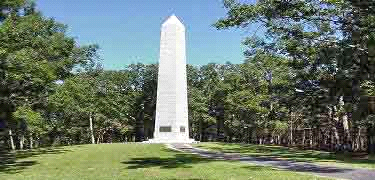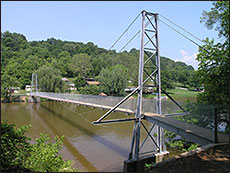1880
The Kings Mountain Centennial Committee planned a celebration for the 100th year after the 1780 battle. Central to the ceremony was the unveiling of a monument.
The 1880 monument plaque


Fell on this battle ground in
defense of liberty
Col James Williams
Maj William Chronicle
—Captains—
John Mattocks, David Beattie
William Edmondson
-First Lieutenants-
Reece Bowen, Thomas McCullough
William Blackburn
Robert Edmondson
–Second Lieutenants–
John Beattie, Andrew Edmondson
Humberson Lyon, James Corry
James Laird, Nathaniel Guist
Nathaniel Dryden, James Phillips
—Privates—
William Rabb, John Boyd, David Duff
Henry Henigar, William Watson
Arthur Patterson, Preston Goforth
——————————————————————————-
The Centennial Committee accomplished the acquisition of about 40 acres encompassing most of the battlefield. They arranged for daily transportation by train from Atlanta and Charlotte to a station between Grover and Kings Mountain NC and by wagon to and from the battlefield. They solicited capital funds and contributions for expenses. They scheduled events and invited dignitaries from around the southeast US.
The typesetting errors of Draper’s “Heroes of Kings Mountain” were chiseled into the monument with a few new errors. Mortally wounded Williams, McCullough, and Laird were shown as killed.
There was a written casualty list of Virginians made on Saturday 07Oct1780. Four decades later Samuel Newell told Governor Campbell that he had read the list. David Beattie recorded some militia roster list for BKM when he returned to Washington County. Though the demise of this manuscript is unknown, we can imagine that Beattie also wrote the casualty report and signed it. His name found its way to the 1880 monument erroneously. This error was corrected for the 1909 monument.
Local legend, Arthur Patterson, was erroneously listed.
Privates and ensigns were shown as lieutenants, Sgt Curry was misspelled, and the Richard Gist name was crisscrossed,
Virginia commissioned no 1st and 2nd lieutenants, just lieutenants and ensigns. These were also called subalterns. The ensign commission was usually for a young single man without military experience. Commissioned captains could raise a company of soldiers and obligate the commonwealth to pay them. Subalterns could only serve as acting captains for specific deployments. Informally for specific militia deployments, subalterns might be designated as first and second alternate commanders after the captain. John Beattie and Andrew Edmondson were commissioned ensigns acting as second lieutenants for the expedition from Sycamore Shoals to Kings Mountain. The other men listed as second lieutenants were privates (for more information, see Virginia Officers .)








